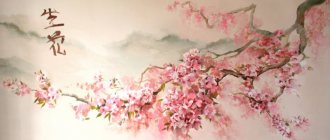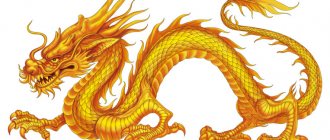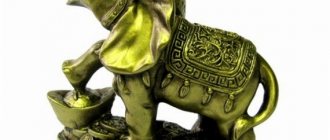Sakura according to feng shui
In Japan, sakura is a very significant symbol; it represents all the most beautiful things that can be found in this world. Delicate oriental cherry blossoms are associated with female beauty, love, the birth of children, renewal and rebirth.
- According to Feng Shui, Sakura is a talisman that attracts happiness, harmony and prosperity, and its five petals collected into a bud are a sign of the unity of spiritual and carnal joys.
The meaning of sakura in eastern culture
Beautiful legend
A beautiful Japanese legend tells about the God of Heaven, who decided to marry one of the daughters of the God of Earth. The older girl was strong as a rock, and the younger one was as beautiful as a wild cherry blossom. It is clear that the groom chose the second without hesitation, but thereby offended his loving father. As a result, he agreed to the marriage, but cast a spell on all the offspring of the married couple:
- From now on, people's lives are full of bright emotions, but short-lived - like sakura buds that are torn from the branches by a careless breeze.
Symbol of the transience of life
In modern tradition, sakura is a symbol of the transience of life. In spring, wild cherry blossoms remind people that happiness, youth and love cannot last forever, so we should enjoy every minute.
- To remember this, Japan annually celebrates Hanami, a special holiday that involves admiring cherry orchards, meditating, and thinking about eternity.
What does sakura mean in feng shui in the house?
Who is it suitable for?
For residents of the Land of the Rising Sun, cherry flowers are a very pleasant and symbolic gift, and its presentation is a wish for prosperity, longevity and peace. Such gifts are especially in demand at weddings; they are often brought to young spouses to emphasize their respect and deep friendship.
- For a couple, planting sakura in the yard is a favorable omen, promising a life of harmony and love.
Where to place it?
Since it is not so easy to grow sakura in an ordinary modern apartment, you can get by with its symbolic image: embroidery, photography, painting.
- According to Feng Shui, such a talisman should be placed in the South-West, in the Marriage Zone.
In this case, he will act as an activator of the love Sector - he will help build a harmonious union based on trust, preserve passion and romance for many years.
Artificial tree
The life of fresh flowers is short-lived, so artificial sakura is quite appropriate at home - a small souvenir tree is convenient to keep on the dressing table or on the bedside table. An excellent option for adding a little oriental sophistication to the bedroom interior and giving yourself a magnificent talisman that will help strengthen family relationships.
Meaning for men
Representatives of the stronger sex also get tattoos with sakura, despite the tenderness of the flower. For men, sakura symbolizes strength and endurance. Graceful flowers or twigs are woven into an ensemble with other Japanese motifs. Such men are followers of Japanese philosophy and cultivate a pragmatic approach to life. The transience of life and the cyclical nature of existence do not frighten them. The most important goal is to leave your mark. Spiritual integrity and the desire for something new means sakura on a man’s body.
Why is sakura a symbol of Japan?
Sakura or Japanese cherry tree is one of the most famous symbols of Japan. When the Land of the Rising Sun is mentioned, the imagination necessarily evokes an association with a flowering ornamental plant of the plum subfamily, covered with a cloud of white and pink petals. The name "sakura" comes from the word "saku", which means "to bloom" and the plural ending "-ra". The ornamental plant blooms from late March to early April. During the remaining seasons, the trees are covered only with a crown of foliage, which falls off by winter.
The brief but magnificent season figuratively represents human life, when blossoming is inevitably followed by withering and death. The days of the spring equinox, when cherry trees bloom, are a time of religious holidays, which include rituals of requests for a good harvest. In this sense, the sakura flower is a symbol of prosperity and good luck.
Another symbolic meaning is to express the connection between people, representing various concepts such as courage, sadness and happiness. Cherry blossoms in Japanese culture are a manifestation of pure beauty. In addition, sakura is a metaphor for the fact that nothing lasts forever in this life. The theme of everything transitory, changing in the world, occupies a central place in the Buddhist religion.
The cherry blossom season coincides with the beginning of the Japanese Old New Year, which until 1873 was celebrated according to the lunar calendar and occurred at the beginning of spring. Hence, in the minds of the Japanese, there is a strong association with the beginning of something new, which is expected with enthusiasm and optimism. In different historical periods, the cherry blossom symbolized Japanese nationalism and militarism.
In Bushido, the code of the samurai, sakura was chosen as an emblem symbolizing the feat of a warrior who gave his life for the emperor. Samurai tattooed a cherry blossom as a reminder of the transience of life, when every day could be the last, so you should appreciate every moment and rejoice at any manifestation of beauty.
During World War II, these flowers were painted on kamikaze planes. Also in national aesthetics, sakura flowers represent the beauty and sexuality of a woman, her ability to control her emotions and dominate men. In the “language of flowers”, a sakura branch also means love and passion. Another meaning given to a delicate flower is innocence, simplicity and spring purity:
“At the time of blossoming Cherries are akin to clouds - Isn’t that why the soul has become more spacious, Like the spring sky...” (Kamo Mabuchi)
The color of the petals depends on the subspecies; there are white, pinkish and deep pink, scarlet, yellow, pale green shades. Japan hosts a spectacular national hanami festival in honor of the beloved tree. Relatives and friends gather for a picnic in cherry parks under the shade of fragrant branches, where they celebrate the beginning of the flowering season. The image of a sakura flower is used to decorate clothes (kimonos), letter paper, covers of notebooks and notepads, and household items, including kitchen utensils.
For centuries, cherry blossoms have inspired Japanese artists, who included cherry blossoms as landscape decorations in elegant prints. The cult of decorative cherries has been adapted in other cultures. In a number of countries, the tree is planted to decorate streets and parks. Since 1912, Washington DC has celebrated the Cherry Blossom Festival every year.
Hanami Festival
One of the most important events for the Japanese is the Hanami holiday, a holiday of admiring the cherry blossoms. It is not for nothing that according to Feng Shui, sakura is a symbol of female beauty, because the pink tree is admired day and night. In a calm and peaceful atmosphere, the Japanese and tourists reflect on the eternal, the perishability of existence. The process of admiring cherry blossoms is called o-hanami.
The tradition itself originated during the era of the imperial Heian dynasty. The rich spent a lot of time under the cherry blossoms, considering the deep meaning of the blossoms. Flowers falling to the ground reminded of the fast flow of life, symbolizing courage and clarity of thoughts.
Why sakura is a symbol of Japan
- Why sakura is a symbol of Japan
- How sakura blooms
- What sakura looks like in 2022
For the Japanese, cherry blossoms are a national holiday. Forecasters make a forecast in advance of the expected flowering dates. Television and radio news reports about the beginning of flowering in every area and in the most famous parks. In this case, the number and types of trees must be listed.
This period also marks the solemn ritual of hanami - admiring sakura flowers. In ancient times, representatives of all classes sat on the ground under the trees - aristocrats, samurai and peasants. At enterprises in modern Japan, a day is specially chosen when the entire team goes to the park to admire the delicate sakura flowers. It is believed that cherry blossoms impart wisdom and divine beauty to their guests.
Night hanami is considered a special celebration, when the soft light of small lanterns suspended under the treetops and the glow of tall lanterns transform cherry blossom gardens into truly heavenly gardens - quiet, warm and divinely beautiful.
The history of ancient holidays is usually associated with mythology. One of the most tragic Japanese legends is dedicated to cherry blossoms. Once upon a time, one of the Japanese villages was under the rule of the cruel Prince Hotta, on whose orders not only peasants, but also members of their families were tortured for the slightest disobedience. Wanting to stop Hotta’s atrocities, the village elder, whose name was Sakura (in Japan, the word “sakura” is masculine), showed the shogun the backs of his children striped with whips.
The shocked ruler gave the order to punish Hotta. But Hotta did not forgive the insult: he grabbed Sakura along with the children, tied them to a tree and flogged them to death. When the cherry blossoms, usually white in color, bloomed the following spring, people were dumbfounded. The flowers turned pink, as if they were stained with the blood of innocent children.
Unfortunately, cherry blossoms are short-lived: they last just over a week. Therefore, its flowers are considered a symbol of the fleeting nature of life. Some Japanese, wanting to prolong their favorite holiday, follow the sakura from city to city. If you follow it from the beginning of flowering in the south to the fall of the last petals in the north, you can admire it for a whole month. It is interesting that flowers appear on the branches of sakura first, and only after they fall do the leaves bloom. Therefore, the flowering tree stands entirely in white or pink.
Since ancient times, sakura has served as a source of inspiration for poets and artists. Modern breeders are showing no less interest in it. Today, more than 300 varieties of sakura grow in Japan, many of which are created by crossing long-known varieties.
Execution Styles
One of the most popular techniques for performing a cherry blossom tattoo is watercolor. As a rule, women resort to its use. In this case, the image turns out to be somewhat refined, delicate, but a little careless due to streaks of coloring pigment.
It is allowed to make both color and black and white drawings of sakura. The latter option is gaining particular popularity; it looks discreet and neat. This is a great solution for men.
When deciding to get a sakura tattoo, you should take into account all the variations of its meaning. It is extremely important to choose the most suitable image so that the tattoo not only looks stylish, but also corresponds to the worldview of its owner.
Tell friends:
Sakura is a symbol of Japan
For many centuries, the sakura flower was the most beloved among the inhabitants of the land of the rising sun and became a symbol of Japanese character. However, this love is explained not only by traditional affection. “In beauty and grace, on which the aesthetic principles of our culture are based, no other flower in the world can compare with it,” wrote Inazo Nitobe (1862-1933) in his famous book “Bushido” (“The Way of the Samurai”). , published in 1900. Spring in Japan is primarily associated with the cherry blossom season. This season begins not when flowers appear on individual trees, but when the entire country turns into a magical garden of white and pink flowers. At the end of March, when the last winter cold subsides, a wave of cherry blossoms rolls over all the Japanese islands. Flowering begins in the south of Kyushu, then, in early April, reaches Tokyo and covers Hokkaido by mid-May. Although this year the cherry blossoms will bloom earlier than usual.
“Hanami”, admiring cherry blossoms, is the most beloved tradition of the Japanese. But, despite the fact that “hanami” literally translates as “watching flowers,” it is no less strongly associated with a good snack and drink on a picnic with family or friends under flowering trees. According to historians, the tradition of admiring cherry blossoms originated at the imperial court in Kyoto during the Heian period (794-1185). But before this period, connoisseurs of beauty were more partial to the blossoming plum (“ume”), whose trees were brought to Japan from China and were considered a symbol of foreign culture. When the practice of sending envoys to China was abolished in 894, the imperial court began to value its own culture and traditions more. So over time, the sakura flower became more popular in Japan. Admiring cherry blossoms is included in the list of official holidays and rituals. One of the most famous “hanami” was held in 1598 by the military leader Toyotomi Hideyoshi. After achieving complete victory over the Separatist princes and establishing control over the entire country, Hideyoshi led a procession of 1,300 people to the Daigo Shrine in Kyoto, where a cherry blossom celebration was held. This event became a favorite subject of numerous poems and productions of the No theater. In the next century, ordinary people began to increasingly share the love for the “hanami” of their masters. During the reign of the Tokugawa shogunate (1603-1867), many cherry trees were brought from Mount Yoshino (Nara Prefecture) to Edo to decorate the new political center of the country. Thanks to the “sankin kotei” system established by the shogun, when every Japanese feudal lord was obliged to live in Edo for at least a year, a huge number of sakura trees were delivered in clothing convoys to the capital from all over the country. At this time, new varieties of trees also appeared, which were bred as a result of both natural and artificial crossing. Now in Japan there are more than 300 types of sakura, although no more than 10 types are natural.
But why has the sakura flower maintained its popularity for such a long time? They say that the transience of cherry blossoms, lasting only a few days, is most consistent with the characteristics of the Japanese character. And the tradition of having a picnic under flowering trees is associated with the ancient belief that pollen falling into a glass of sake gives strength and health. Sakura flowers were also a favorite subject of many famous artists. They appear in countless paintings, poems, and later photographs and films, not to mention the fact that sakura is the most popular design on women's kimonos. Many shops and department stores are now decorated with cherry blossoms, but it looks less romantic since the flowers are mostly made of plastic. Food and drinks available only during the cherry blossom season appear on the shelves. The most famous of these are “sakura cha,” tea with salted sakura petals, and “sakura mochi,” glutinous rice cakes filled with sweet red beans, wrapped in salted sakura leaves. In each store you can also buy “hanami bento” - a picnic box with various snacks, desserts and cocktails. But not only the Japanese appreciate the beauty of cherry blossoms. Anyone who visits Japan at this time will be delighted to see flowering trees fluttering in the wind (“hanafubuki”), as well as cherry blossoms in the light of the moon or paper lanterns (“yozakura”). This impression will remain in memory for many years. Although there are many famous places in every region where you can admire the cherry blossoms, everyone closely follows radio and television reports about where you can see the most beautiful blossoms at the moment. In Tokyo, sakura usually blooms in April, and this season is impossible to miss. One of the most famous “hanami” places in Tokyo is Shinjukugyoen National Park, where 1,500 cherry trees of 75 species grow. It is followed by Ueno Park, Tokyo's largest city park with an area of 626,000 square meters and 1,100 trees. From late March to early April, a city festival dedicated to the cherry blossom season will be held here. No less famous is Sumida Park, where about 400 trees grow and unique lighting is installed under them.
Spring Festival: sakura in the interior of a city apartment
Spring has fully entered our homes. To some a little earlier, to others a little later, it brings the warmth and aroma of flowering trees - apple trees, plums, cherries... True, these trees do not grow in the big cities of Russia. We can see them when we go out of town and make our own Hanami. This is the name of the cherry blossom viewing festival in Japan. Every year he inspires thousands of designers who are sure that sakura in the interior is wonderful!
In Japan, the Hanami Festival takes place every year from March to April and attracts many people from all over the world. Not only ordinary tourists come, but also professional photographers, artists, sculptors and even designers who draw inspiration from the delicate white and pink flowers of the Japanese cherry blossoms. Let's get inspired too!
Sakura is a symbol of Japan
When the god of the mountains invited Ninigi, the grandson of the Sun goddess, to marry one of his daughters, he decided that if he gave preference to the eldest, High Rock, the life of their descendants would be eternal and durable, like stones. But if he prefers the youngest, Blooming, then the life of their children, regardless of social status, will be beautiful, but short, like cherry blossoms. Ninigi chose Blooming and became the ancestor of the Japanese emperors.
The Japanese, annually contemplating the beauty of this amazing plant and looking at the fragility of its flowering, reflect on the fact that beauty does not last forever, and life is fleeting and fragile. Therefore, it very much resembles a crumbling sakura flower - although it is beautiful, it leaves too soon: it is not for nothing that cherry blossoms symbolize the frailty of life and the fickleness of existence.
Description of the tree
Sakura is the name given to trees of the rose family, subfamily of plums (species: small-serrate cherry), most of which perform a purely decorative function: they bloom, but do not bear fruit (unlike other trees of its species, Japanese sakura is grown not for its berries, but for its flowers). There are 16 types of sakura and more than 400 varieties.
Despite the fact that sakura trees can be found mainly in the south of the northern hemisphere: in China, Korea, and the Himalayas, the largest number of trees of this type grows in Japan: nine out of sixteen species and a considerable number of varieties. There are especially a lot of someyoshino (white sakura with huge flowers) and shidarezakura (weeping willow) here - this color of sakura has a pink tint.
Sakura grows very well next to other plants of its species, which, depending on how they were planted, produce a different impression. For example, tree branches planted in parallel rows can intertwine with each other at the top, forming a blooming arch above your head - this looks especially chic if at this time the flowers have already begun to gradually fall and a person is walking on the carpet that the sakura petals created.
The height of the plant depends on its age, but is usually about 8 meters (but there are also taller trees, for example, one of the oldest sakura in the world, whose age is 1800 years, has about 24 meters in height).
The bark is smooth, cut across the entire surface of the tree with small horizontal cracks of a gray, green or red hue, and the wood of the tree is very flexible due to the high amount of resin in it.
The leaves are oval or spear-shaped with slightly serrated edges. When a sakura branch blooms, it is completely covered with flowers, mostly white or pink, with each inflorescence consisting of several double flowers, usually having 5 petals. The Japanese managed to develop species whose flowers contain about 50 petals, the diameter of which is about 50-60 mm - in appearance they even resemble roses, peonies, and chrysanthemums.
Sakura petals can be of different colors: white and pink sakura are common, but you can often see flowers in red, crimson, yellow and even green and variegated tones. Since sakura flowers bloom even before sakura leaves appear on the tree, it seems as if a huge number of delicate inflorescences are clinging to a dead and bare trunk (which is why the flowering period in Japan is also associated with rebirth).
When the sakura petals begin to fade, but have not yet fallen from the tree, and the sakura branch is overgrown with the first leaves, the plant looks extremely elegant and summery (the Japanese call it Ha-Zakura, which means “sakura with leaves”).
Few trees of this type bear fruit, and if they do produce a harvest, the sakura fruits (sakurambo) are usually very small, cherry-colored, have a large seed, tightly covered with thin pulp, and taste very sour and tart. They are sold in small boxes and are extremely expensive.
Flowering time
Cherry blossoms begin in January on the island. Okinawa (located in the south) and ends on the island. Hokkaido, thus moving north. The period when this tree blooms largely depends on its species: some plants begin to bloom in winter, others in late spring. For example, such well-known species as:
- Fuyu-Zakura - blooms in the last month of autumn;
- Yama-dzarkura is an early plant, blooms at the end of March;
- Someyoshino - in early April;
- Yae-zakura - in mid-spring;
- Kasumi-zakura - in early May.
When the flower fully opens, it remains that way for about a week. How long it will bloom depends largely on the weather and temperature - the colder it is, the longer you can contemplate sakura flowers. But strong winds and rain, on the contrary, will significantly reduce cherry blossoms.
Hanami Festival
Cherry blossoms in Japan are celebrated at the state level: the official opening of Hanami (“Contemplation of Flowers”) takes place in Tokyo’s main park, Shinjuku, and not only famous politicians, but also members of the imperial family take part in it.
During this period, numerous gardens, parks, squares and other places where cherry trees bloom are visited by a huge number of people; viewing is especially popular in the evening, when the sakura branch is very beautifully illuminated. While contemplating, people have picnics, relax, and often use the Hanami holiday for personal interests - they negotiate, strengthen contacts, and make new acquaintances.
Use of wood in everyday life
The Japanese make sour wine from the fruits of this plant or add it to rice during cooking. They also found a use for leaves and petals - they pickle them, after which the leaves are used as an edible coating for “sakura-mochi” sweets made from rice, and sakura petals do a good job as an odorous seasoning. During the holidays, they are often dipped in boiling water or green tea. When they come into contact with hot water, the sakura petals open and delight guests with their appearance.
Bonsai
Experts consider sakura to be an ideal tree for bonsai - it grows slowly, so having bought a young plant, you don’t have to worry that in a year or two it will have to be replanted outside, especially since the vertical growth of the tree will be restrained by constant pruning of new shoots and pruning of roots.
You can buy such a plant in special stores. A small cherry blossom tree looks the same as an older tree, only the diameter of its inflorescences does not exceed one centimeter (usually pink). When creating a bonsai, you must remember that the plant, although small, is alive, and not a stone, insensitive toy, and therefore, if it is not given enough attention or the wrong approach is taken, it may die.
The container for bonsai should be shallow and its diameter should be from 15 to 20 cm. Sakura bonsai prefers to grow on well-fertilized soil. It is advisable to add organic fertilizers to the soil a month before planting, nitrogen - simultaneously with planting, potassium and phosphorus, which promote the circulation of useful substances in the plant - in the summer. If the soil is poorly fertilized, the amount of humus should be from 8 to 12 g/dm3, and in a moderately fertilized soil it should be about five.
Japanese sakura loves good lighting, and therefore must be in a bright place (if it stands in the shade, there is a risk of powdery mildew). When looking for a place for a plant, you should take into account that it really does not like drafts.
Water the bonsai tree once a day (half a glass of water), less often in winter. The small plant is replanted annually, cutting off 1/3 of the rhizomes (branches can also be done, but don’t get carried away, since sakura doesn’t like that). If caterpillars, woodlice, red mites, bark beetles and aphids are found in the soil, you must immediately destroy them with insecticides, otherwise they will very quickly destroy the plant.
Sakura
The most favorite flowers of the Japanese
Sakura is a tree of the Plum subfamily of the Rosaceae family. The color of the flowers varies from snow-white to crimson and scarlet. Japanese law does not define the “state flower,” but sakura has become so firmly established in Japanese culture that it can be considered a symbol of Japan along with the chrysanthemum.
There are more than 600 varieties of cherry blossoms in Japan, including native and hybrid varieties. Somei-yoshino is the most common
with five-petaled pale pink flowers, developed in the mid-Edo period (1603-1868) and spread throughout the country from the Meiji period (1869-1912).
Sakura variety Somei-yoshino
The Japanese cherry tree occupies such an important place in Japanese culture that the word “flowers” in literature is often used as a synonym for the word “sakura”, dating back to the Heian period (794-1192). Spring picnics with relatives, colleagues, and acquaintances under the cherry blossoms are an integral attribute of spring in Japan. In all regions of Japan there are places famous for the beauty of cherry blossoms, and even some individual cherry trees are famous throughout the country. Such, for example, is the very old “Sakura of the Age of the Gods” ( Jindaizakura
) in Yamanashi Prefecture, which is about 2000 years old, or "Sakura Falls in Miharu" (
Miharu-takizakura
), which is more than 1000 years old, in Fukushima Prefecture.
Cherry blossoms are also closely connected with new meetings and partings, with turning points in human life. The financial and academic year in Japan begins on April 1, and this date falls during the time when cherry blossoms bloom in Kanto and more western regions (usually from the last ten days of March to mid-April). This is when school graduation events take place, this is the period of admission to school, to work, and those who successfully passed the entrance exams are said to have “sakura blossoms.”
Ueno Park in Tokyo while admiring the sakura
Sakura in Japanese cuisine
Sakura is not only admired. Wood, flowers, leaves, and sakura fruits are used on the farm. The fruits of some varieties are eaten. Soft flowers of oshimazakura
and
yaezakura
are salted and then prepared into sweets or other dishes.
Pickled sakura flowers, if thrown into hot water, take on their previous shape, as if blooming again, and therefore have a benevolent meaning and a drink from them, sakurayu
, are a favorite treat during dates arranged for the purpose of marriage (
o-miai
), or at weddings. In addition, these flowers are used to decorate bread or cookies, and are also boiled with rice to add flavor.
Cherry blossom drink - sakurayu (left) Pink sakuramochi rice cake made from glutinous rice and botamochi made from a mixture of glutinous and regular rice (right)
Sakura in Japanese culture
Sakura was first mentioned in the chronicle-mythological collection “Annals of Japan” ( Nihon shoki
), completed in 720. It tells how a flower fell into a bowl of sake held by the 5th century Emperor Rityu.
In later literature, there are many works in which sakura appears. They are not only about the beauty of flowers and hanami
, “flower admiration” under flowering trees. The exquisite features of beautiful women are likened to sakura flowers, they express respect to sakura, which blooms for so short a time and then crumbles overnight, they see in it a courageous acceptance of one’s fate and cite it as an example of impermanence, the frailty of existence. Thus, sakura became a symbol of the fleeting beauty of the transient, having a certain influence on the formation of ideas about life and death.
The Japanese love for sakura survived the post-war reforms and now manifests itself in music. One of the most famous songs, a kind of “calling card” of Japan, is called “Sakura, Sakura”, and in general the number of songs with this word in the title has exceeded a hundred; songs whose lyrics mention sakura are impossible to count.
Cherry blossom festival in images
The cherry blossom festival became an inspiration not only for Japanese poets who wrote beautiful haiku and tankas about it, but also for artists of all times.
And later for photographers. Their paintings and photographs are a wonderful addition to decorating our interior.
Sakura
The most favorite flowers of the Japanese
Sakura is a tree of the Plum subfamily of the Rosaceae family. The color of the flowers varies from snow-white to crimson and scarlet. Japanese law does not define the “state flower,” but sakura has become so firmly established in Japanese culture that it can be considered a symbol of Japan along with the chrysanthemum.
There are more than 600 varieties of cherry blossoms in Japan, including native and hybrid varieties. Somei-yoshino is the most common
with five-petaled pale pink flowers, developed in the mid-Edo period (1603-1868) and spread throughout the country from the Meiji period (1869-1912).
Sakura variety Somei-yoshino
The Japanese cherry tree occupies such an important place in Japanese culture that the word “flowers” in literature is often used as a synonym for the word “sakura”, dating back to the Heian period (794-1192). Spring picnics with relatives, colleagues, and acquaintances under the cherry blossoms are an integral attribute of spring in Japan. In all regions of Japan there are places famous for the beauty of cherry blossoms, and even some individual cherry trees are famous throughout the country. Such, for example, is the very old “Sakura of the Age of the Gods” ( Jindaizakura
) in Yamanashi Prefecture, which is about 2000 years old, or "Sakura Falls in Miharu" (
Miharu-takizakura
), which is more than 1000 years old, in Fukushima Prefecture.
Cherry blossoms are also closely connected with new meetings and partings, with turning points in human life. The financial and academic year in Japan begins on April 1, and this date falls during the time when cherry blossoms bloom in Kanto and more western regions (usually from the last ten days of March to mid-April). This is when school graduation events take place, this is the period of admission to school, to work, and those who successfully passed the entrance exams are said to have “sakura blossoms.”
Ueno Park in Tokyo while admiring the sakura
Sakura in Japanese cuisine
Sakura is not only admired. Wood, flowers, leaves, and sakura fruits are used on the farm. The fruits of some varieties are eaten. Soft flowers of oshimazakura
and
yaezakura
are salted and then prepared into sweets or other dishes.
Pickled sakura flowers, if thrown into hot water, take on their previous shape, as if blooming again, and therefore have a benevolent meaning and a drink from them, sakurayu
, are a favorite treat during dates arranged for the purpose of marriage (
o-miai
), or at weddings. In addition, these flowers are used to decorate bread or cookies, and are also boiled with rice to add flavor.
Cherry blossom drink - sakurayu (left) Pink sakuramochi rice cake made from glutinous rice and botamochi made from a mixture of glutinous and regular rice (right)
Sakura in Japanese culture
Sakura was first mentioned in the chronicle-mythological collection “Annals of Japan” ( Nihon shoki
), completed in 720. It tells how a flower fell into a bowl of sake held by the 5th century Emperor Rityu.
In later literature, there are many works in which sakura appears. They are not only about the beauty of flowers and hanami
, “flower admiration” under flowering trees. The exquisite features of beautiful women are likened to sakura flowers, they express respect to sakura, which blooms for so short a time and then crumbles overnight, they see in it a courageous acceptance of one’s fate and cite it as an example of impermanence, the frailty of existence. Thus, sakura became a symbol of the fleeting beauty of the transient, having a certain influence on the formation of ideas about life and death.
The Japanese love for sakura survived the post-war reforms and now manifests itself in music. One of the most famous songs, a kind of “calling card” of Japan, is called “Sakura, Sakura”, and in general the number of songs with this word in the title has exceeded a hundred; songs whose lyrics mention sakura are impossible to count.
Sources: https://geo-storm.ru/vechnye-voprosy/pochemu/pochemu-sakura-simvol-japonii/ https://www.kakprosto.ru/kak-889521-pochemu-sakura-yavlyaetsya-simvolom-yaponii https ://www.astrostar.ru/articles/drevnie-kultury/yaponiya/sakura-simvol-yaponii.html https://awesomeworld.ru/zhivaya-priroda/mir-rastenij/sakura-simvol-yaponii.html https:/ /www.nippon.com/ru/features/jg00011/ https://www.nippon.com/ru/features/jg00011/ https://www.koolinar.ru/recipe/view/49680











